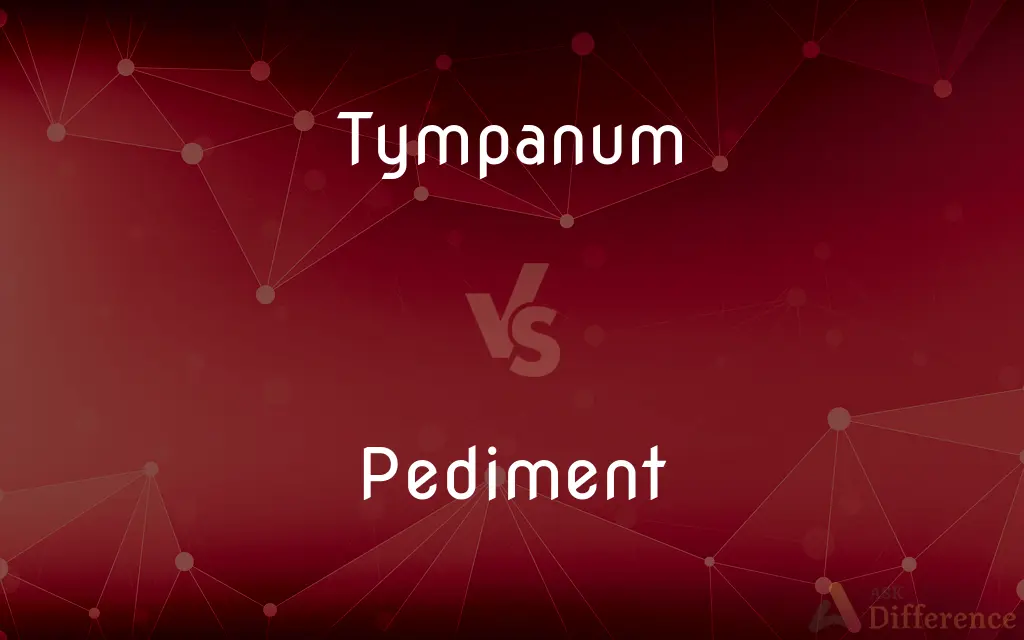Tympanum vs. Pediment — What's the Difference?
By Tayyaba Rehman & Urooj Arif — Updated on April 18, 2024
Tympanum, often found in church architecture, is a semi-circular or triangular decorative wall surface over an entrance, bounded by a lintel and arch. Pediment, common in classical architecture, is a triangular upper part of the front of a building.

Difference Between Tympanum and Pediment
Table of Contents
ADVERTISEMENT
Key Differences
A tympanum is a key architectural element typically located within the area enclosed by a lintel and an arch above doorways, particularly in Gothic and Romanesque churches. This area is often richly decorated with sculptures and reliefs depicting religious scenes. On the other hand, a pediment is a triangular gable found above the horizontal structure of the entablature, usually seen in classical architecture like Greek temples and Renaissance buildings, where it serves as a crowning element for windows, doors, and monumental buildings.
Tympanums are primarily used for ornamental purposes and are often loaded with iconography that is specific to the building's religious and cultural context. These decorations serve to convey spiritual themes or biblical stories to the faithful. Whereas pediments, while they can also be decorative, more often conform to the strict proportions and aesthetics of classical architecture, focusing on symmetry and balance rather than narrative content.
The shape of a tympanum is typically semi-circular or triangular, fitting neatly into the arch above the church portal. It forms an integral part of the building’s spiritual and visual approach. In contrast, pediments are always triangular and are designed to mimic the classical style of ancient Greece and Rome, enhancing the grandeur and formality of a building.
Material-wise, tympanums are generally crafted from the same materials as the buildings they adorn, often stone or wood, and feature high relief sculptures. Conversely, pediments are usually constructed from stone or stucco and may include detailed sculptures or plain surfaces, depending on the architectural style and period.
In terms of symbolism, the tympanum often serves a didactic function, teaching or reminding viewers of specific theological principles or narratives from Christian theology. On the contrary, the pediment often incorporates elements from mythology or allegory, aligning with the philosophical and cultural expressions typical of the era of the building.
ADVERTISEMENT
Comparison Chart
Shape
Semi-circular or triangular, within an arch
Always triangular, topping an entablature
Location
Above doorways, especially in churches
Above entrances or significant facades
Decoration
Religious scenes, high reliefs
May include sculptures or be plain
Material
Usually stone or wood
Often stone or stucco
Function
Decorative and didactic, conveying messages
Primarily decorative, enhancing grandeur
Compare with Definitions
Tympanum
A wall section at the upper part of the front of a building, often semicircular.
The ancient abbey’s tympanum remains intact.
Pediment
A crowning element for portals, windows, or facades.
Each window on the building is topped with a small pediment.
Tympanum
The space enclosed by a lintel and an arch over a doorway.
The artist emphasized the Last Judgment in the tympanum’s design.
Pediment
The triangular upper part of the front of a classical building.
The museum’s impressive pediment features sculptures of the muses.
Tympanum
An ornamental feature depicting religious or historical themes.
The cathedral's tympanum illustrates the Ascension of Christ.
Pediment
Often associated with Greek and Roman architectural styles.
The pediment of the old courthouse follows classical Greek aesthetics.
Tympanum
A key element in Romanesque and Gothic architecture.
The gothic tympanum is known for its complexity and symbolic artistry.
Pediment
Can be plain or decorated, depending on the style and era.
The pediment above the entrance was adorned with baroque carvings.
Tympanum
A decorative area within an arch above a doorway, especially in churches.
The church's tympanum featured a carved depiction of Saint Michael.
Pediment
Serves as an architectural element that symbolizes formality and grandeur.
The grand villa was designed with a large, imposing pediment.
Tympanum
(Anatomy)See middle ear.
Pediment
A pediment is an architectural element found particularly in Classical, Neoclassical and Baroque architecture, and its derivatives, consisting of a gable, usually of a triangular shape, placed above the horizontal structure of the lintel, or entablature, if supported by columns. The tympanum, the triangular area within the pediment, is often decorated with relief sculpture.
Tympanum
See eardrum.
Pediment
The triangular upper part of the front of a classical building, typically surmounting a portico.
Tympanum
(Zoology)A membranous external auditory structure, as in certain insects.
Pediment
A broad, gently sloping expanse of rock debris extending outwards from the foot of a mountain slope, especially in a desert.
Tympanum
The ornamental recessed space or panel enclosed by the cornices of a triangular pediment.
Pediment
A wide, low-pitched gable surmounting the façade of a building in the Grecian style.
Tympanum
A similar space between an arch and the lintel of a portal or window.
Pediment
A triangular element, similar to or derivative of a Grecian pediment, used widely in architecture and decoration.
Tympanum
The diaphragm of a telephone.
Pediment
(Geology) A broad, gently sloping rock surface at the base of a steeper slope, often covered with alluvium, formed primarily by erosion.
Tympanum
(archaic) A drum.
Pediment
(architectural element) A classical architectural element consisting of a triangular section or gable found above the horizontal superstructure (entablature) which lies immediately upon the columns; fronton.
Tympanum
Any of various anatomic structures in various animals with analogy to a drum head:
Pediment
Originally, in classical architecture, the triangular space forming the gable of a simple roof; hence, a similar form used as a decoration over porticoes, doors, windows, etc.; also, a rounded or broken frontal having a similar position and use. See Temple.
Tympanum
The eardrum (tympanic membrane, membrana tympanica).
Pediment
A triangular gable between a horizontal entablature and a sloping roof
Tympanum
The main portion of the middle ear: the tympanic cavity (cavitas tympani).
Tympanum
A thin tense membrane covering the hearing organ on the leg or body of some insects, sometimes adapted (as in cicadas) for producing sound.
Tympanum
(zootomy) A membranous resonator in a sound-producing organ in frogs and toads.
Tympanum
(zootomy) in certain birds The labyrinth at the bottom of the windpipe.
Tympanum
(architecture) A vertical recessed triangular space between the sides of a pediment, typically decorated
Tympanum
The recessed triangular space within an arch, and above a lintel or a subordinate arch, spanning the opening below the arch
Tympanum
(engineering) A drum-shaped wheel with spirally curved partitions by which water is raised to the axis when the wheel revolves with the lower part of the circumference submerged; used for raising water, as for irrigation.
Tympanum
The ear drum, or middle ear. Sometimes applied incorrectly to the tympanic membrane. See Ear.
Tympanum
One of the naked, inflatable air sacs on the neck of the prairie chicken and other species of grouse.
Tympanum
The recessed face of a pediment within the frame made by the upper and lower cornices, being usually a triangular space or table.
Tympanum
A drum-shaped wheel with spirally curved partitions by which water is raised to the axis when the wheel revolves with the lower part of the circumference submerged, - used for raising water, as for irrigation.
Tympanum
The main cavity of the ear; between the eardrum and the inner ear
Tympanum
The membrane in the ear that vibrates to sound
Tympanum
A large hemispherical brass or copper percussion instrument with a drumhead that can be tuned by adjusting the tension on it
Common Curiosities
How do tympanums contribute to the overall architecture of a building?
Tympanums add a significant ornamental and narrative element to a building, often depicting religious scenes that complement the spiritual purpose of the structure.
What materials are commonly used to create pediments?
Pediments are typically made from stone, marble, or stucco, reflecting their origins in classical architecture where durability and aesthetics were crucial.
What is the symbolic significance of a tympanum?
The tympanum often has symbolic significance, typically portraying theological virtues, biblical narratives, or saints, serving both decorative and catechetical purposes.
How do pediments affect the perception of a building?
Pediments contribute to the symmetry and balance of a building's facade, enhancing its aesthetic appeal and making it appear more stately and structured.
How are tympanums different from other architectural ornaments?
Tympanums are unique in that they fill the space within an arch above a doorway, specifically designed to fit this area, unlike freestanding sculptures or other decorative elements.
What are some iconic buildings known for their pediments?
Iconic buildings with notable pediments include the Parthenon in Athens, the Pantheon in Rome, and the United States Supreme Court building.
Can pediments be found in modern architecture?
Yes, pediments are used in modern architecture, often as a nod to classical influences, lending a sense of tradition and grandeur to contemporary buildings.
Are there regional variations in tympanum designs?
Yes, tympanum designs can vary significantly between regions, reflecting local religious practices, cultural symbols, and historical contexts.
How do pediments contribute to the structural integrity of a building?
While primarily decorative, pediments can also help to distribute the weight of the roof and upper structure evenly across the columns or walls they surmount, contributing to the building's structural stability.
What is the role of color in tympanums and pediments?
Originally, both tympanums and pediments were often brightly painted to enhance their visibility and impact; however, many have faded over time or have been left in their natural stone color in more modern restorations.
Can pediments include text or inscriptions?
Yes, pediments sometimes include inscriptions or dedications, especially in public or governmental buildings, to commemorate historical events or important figures.
What is the impact of the Reformation on tympanum decorations?
The Reformation often led to the simplification or destruction of elaborate tympanum decorations in churches, as iconoclasm and a preference for simpler, less ornate designs took hold.
Share Your Discovery

Previous Comparison
Bag vs. Packet
Next Comparison
Bellicose vs. BelligerentAuthor Spotlight
Written by
Tayyaba RehmanTayyaba Rehman is a distinguished writer, currently serving as a primary contributor to askdifference.com. As a researcher in semantics and etymology, Tayyaba's passion for the complexity of languages and their distinctions has found a perfect home on the platform. Tayyaba delves into the intricacies of language, distinguishing between commonly confused words and phrases, thereby providing clarity for readers worldwide.
Co-written by
Urooj ArifUrooj is a skilled content writer at Ask Difference, known for her exceptional ability to simplify complex topics into engaging and informative content. With a passion for research and a flair for clear, concise writing, she consistently delivers articles that resonate with our diverse audience.
















































